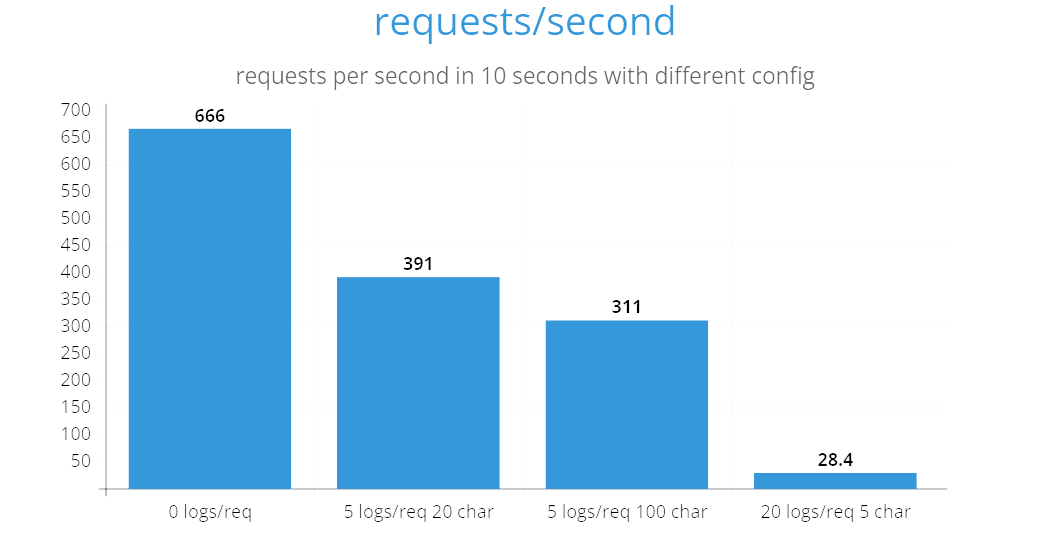on
How can logging impact a Golang backend?
This article is the answer to a small question I have always asked myself developing a backend. How much logging impact the performance? Is there a good reason why we keep the logging level to ERROR in production?
Short Answer: very much YES.
Analysis
Backend Setup
Since I was already playing with my Golang backend for my hobby project binary-duel, I decided to add a simple route with two configurable parameters:
- number of logs
- number of characters in each log
In my backend I have used https://github.com/sirupsen/logrus as the logging library.
func Logging(c *gin.Context) {
var json struct {
NumLogs int
Size int
}
if err := c.ShouldBindJSON(&json); err != nil {
c.JSON(http.StatusBadRequest, gin.H{"error": err.Error()})
return
}
for i := 0; i < json.NumLogs; i++ {
logString := randStringRunes(json.Size) // generate a random string of fixed size
utils.Log.Debug(logString) // utils function to log, using logrus
}
c.Status(http.StatusOK)
}
Load Test setup
I used https://www.npmjs.com/package/autocannon to load test this route with different (number of logs, size) combination, and finally extract metrics. The idea is to send as many requests as possible in 10 seconds.
Here is the configuration.
const autocannon = require('autocannon')
const instance = autocannon({
url: 'http://ubuntucore:8080/logging',
method: 'POST',
headers: {
'Content-Type': 'application/json'
},
body: JSON.stringify({
"NumLogs": "<num>",
"Size": "<size>"
}),
connections: 10,
pipelining: 1,
duration: 10, // seconds
}, console.log)
// this is used to kill the instance on CTRL-C
process.once('SIGINT', () => {
instance.stop()
})
// just render results
autocannon.track(instance, { renderProgressBar: true })
Hardware Setup
The backend is deployed into a Raspberry 2 Model B in my local network, and the load test is run using my PC.
Results
0 Logs per Request
Latency
| Stat | 2.5% | 50% | 97.5% | 99% | Avg | Stdev | Max |
|---|---|---|---|---|---|---|---|
| Latency | 6 ms | 13 ms | 29 ms | 35 ms | 14.49 ms | 9.12 ms | 188 ms |
Req/s
| Stat | 1% | 2.5% | 50% | 97.5% | Avg | Stdev | Min |
|---|---|---|---|---|---|---|---|
| Req/Sec | 586 | 586 | 662 | 723 | 666.6 | 44.01 | 586 |
| Bytes/Sec | 44 kB | 44 kB | 49.7 kB | 54.2 kB | 50 kB | 3.3 kB | 44 kB |
5 Logs of 20 characters per Request
Latency
| Stat | 2.5% | 50% | 97.5% | 99% | Avg | Stdev | Max |
|---|---|---|---|---|---|---|---|
| Latency | 8 ms | 24 ms | 47 ms | 59 ms | 25.01 ms | 11.13 ms | 107 ms |
Req/s
| Stat | 1% | 2.5% | 50% | 97.5% | Avg | Stdev | Min |
|---|---|---|---|---|---|---|---|
| Req/Sec | 334 | 334 | 392 | 435 | 391.7 | 30.84 | 334 |
| Bytes/Sec | 25.1 kB | 25.1 kB | 29.4 kB | 32.6 kB | 29.4 kB | 2.31 kB | 25.1 kB |
5 Logs of 100 characters per Request
Latency
| Stat | 2.5% | 50% | 97.5% | 99% | Avg | Stdev | Max |
|---|---|---|---|---|---|---|---|
| Latency | 10 ms | 30 ms | 59 ms | 70 ms | 31.54 ms | 13.62 ms | 142 ms |
Req/s
| Stat | 1% | 2.5% | 50% | 97.5% | Avg | Stdev | Min |
|---|---|---|---|---|---|---|---|
| Req/Sec | 251 | 251 | 304 | 351 | 311.61 | 30.41 | 251 |
| Bytes/Sec | 18.8 kB | 18.8 kB | 22.8 kB | 26.3 kB | 23.4 kB | 2.28 kB | 18.8 kB |
20 Logs of 5 characters per Request
Latency
| Stat | 2.5% | 50% | 97.5% | 99% | Avg | Stdev | Max |
|---|---|---|---|---|---|---|---|
| Latency | 20 ms | 58 ms | 130 ms | 142 ms | 62.09 ms | 26.08 ms | 182 ms |
Req/s
| Stat | 1% | 2.5% | 50% | 97.5% | Avg | Stdev | Min |
|---|---|---|---|---|---|---|---|
| Req/Sec | 111 | 111 | 166 | 202 | 159.31 | 28.4 | 111 |
| Bytes/Sec | 8.33 kB | 8.33 kB | 12.5 kB | 15.2 kB | 11.9 kB | 2.13 kB | 8.32 kB |
Conclusion

The results are conclusive:
- logs can impact the performance of your backend
- log the less you can!
- it is way better to log a long message instead of logging multiple small messages
Do you have any ideas or comments?
Leave them under this HK post or email me via simonedutto8+binaryduel_at_gmail.com
If you are interested in other articles: read You don’t need a database, a queue, a distributed system: Go is enough.